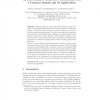Free Online Productivity Tools
i2Speak
i2Symbol
i2OCR
iTex2Img
iWeb2Print
iWeb2Shot
i2Type
iPdf2Split
iPdf2Merge
i2Bopomofo
i2Arabic
i2Style
i2Image
i2PDF
iLatex2Rtf
Sci2ools
PKC
2004
Springer
2004
Springer
An RSA Family of Trap-Door Permutations with a Common Domain and Its Applications
Abstract. Bellare, Boldyreva, Desai, and Pointcheval [1] recently proposed a new security requirement of the encryption schemes called “keyprivacy.” It asks that the encryption provide (in addition to privacy of the data being encrypted) privacy of the key under which the encryption was performed. Incidentally, Rivest, Shamir, and Tauman [2] recently proposed the notion of ring signature, which allows a member of an ad hoc collection of users S to prove that a message is authenticated by a member of S without revealing which member actually produced the signature. We are concerned with an underlying primitive element common to the key-privacy encryption and the ring signature schemes, that is, families of trap-door permutations with a common domain. For a standard RSA family of trap-door permutations, even if all of the functions in a family use RSA moduli of the same size (the same number of bits), it will have domains with different sizes. In this paper, we construct an RSA fami...
| Added | 02 Jul 2010 |
| Updated | 02 Jul 2010 |
| Type | Conference |
| Year | 2004 |
| Where | PKC |
| Authors | Ryotaro Hayashi, Tatsuaki Okamoto, Keisuke Tanaka |
Comments (0)

